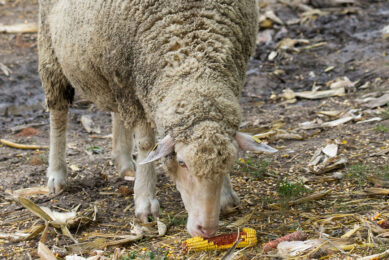The planned output of the new feed mill is 25,000 tons per year, of which the majority will be pig feed (20,000 tons). The remaining 5,000 tons will be split equally between broiler and quail feed.
Mr Gil Garcia, president of the company president and designer of the mill oversees a work force of 43 staff. The mill operates on a 12 hour one shift system but if necessary this can be doubled up. Most of the raw materials and finished feeds are transported in 50kg bags and the mill staff can be seen carrying two such bags on their shoulders, often up steps and ramps – no mean feat it should be said. Many of the more extreme physically demanding jobs are being mechanised and some raw materials are now being brought in on pallets and then are moved around the mill by fork lift trucks.
Increased interest in pellets
Large silos which are favoured in some parts of the world are not used in the Philippines as the high humidity means that a lot of bridging occurs. Hence holding bins are small and many ingredients are stacked in sacks on the warehouse floor. Feeds are produced in a variety of physical forms. Much of the poultry diets are produced in mash form whereas meal is still common for pig feeds. Pelleted pig feeds though are becoming more popular because of the reduced waste with this form of feed. ”The mill produces a 4mm breeder ration, 3mm starter and a 2.5mm booster “stated Mr Garcia. The feed bag label lists the crude protein, fibre, fat and moisture all in percentages. Mr Garcia has customers as far as 600km away from his mill and feed is transported across the country on large articulated trucks. The mill also produces concentrates as well as finished feeds.
Expensive raw materials
With regard to raw materials, prices have increased dramatically since the summer of 2007.
Corn is grown mainly in the north of the Philippines and it’s possible to grow between one and three crops per year depending on the part of the country and plantings have increased by 15-20%. Feed manufacturers prefer to use local corn as there is 35% duty on imported maize. The land that grows corn is also suited for rice cultivation but because input costs are greater with rice, farmers prefer to grow corn. Banana meal, cassava, copra, wheat bran and rice bran are common feed ingredients and last year rice bran cost the same as corn to buy. Interestingly wheat bran is imported in pellets, in bags, from Indonesia. Cassava is imported from Thailand plus San Miguel is getting Philippino farmers to grow cassava on contract. Soya bean meal is imported from the USA, Argentina and India with some full fat soya being used in pig starter diets.
Ingredients
“Aflotoxin and mycotoxin contamination are a problem in soya and all our soya is tested for DOM. Zearalenon is also a problem in copra as well as soya. Consequently we use a lot of Olmix’s MTox Plus mycotoxin inhibitor, commented Mr Garcia. Fishmeal is imported from the Seychelles and Peru. In addition tuna fishmeal is also available but the quality is quite variable. “Meat and bone meal analyses out at 55%CP and is another option as far as sources of protein are concerned. Whey powder and skimmed milk powder are used in our piglet starter diets, where higher quality protein sources are needed.
Synthetic lysine, methionine and threonine are used to redress amino acid imbalances in the natural protein sources and these synthetics are imported from many Asian countries, in particular China and Thailand. Tallow is added to some diets to boost the energy levels but we have problems heating it and keeping it liquid” added Mr Garcia. Vitamins and minerals are generally imported.
Mr Garcia is also very proud of the fact that his company is the only one in the Philippines carrying out antibiotic sensitivity tests.
Backyard farmers
In the western hemisphere a guy with a few pigs or hens in his yard is considered a hobby farmer, looking for the “good life“, but in the Philippines the backyard farmers make a massive contribution in terms of the nation’s food
|
| Pelleted pig feeds though are becoming more popular because of the reduced waste with this form of feed. |
production. Drive through any village or small town in the Philippines and you will pass numerous open fronted shops with a bewildering assortment of sacks displaying a wide variety of feeds for pigs and poultry. These village stores also have a wide variety of antibiotics for sale as well. Backyard pigs tend to be fed fairly fibrous diets supplemented with concentrates from these village feed stores. Because the nutrition is by nature variable pigs tend to be fat but if this pork ends up on the family’s table it’s not that much of a problem plus fat is still enjoyed in the East – after all, that’s where the flavour is. Cock fighting is big business in the Philippines with huge sums of money being bet on fights. Owners and their birds travel the length and breadth of the country to compete in cock fights. Hardly surprisingly feed manufacturers make specific diets for these birds, such as Stag Developer and Stag Maintainer, based on corn, wheat, peas sunflower meal and sorghum.
Source: Feed Tech magazine Volume 12 No.5












